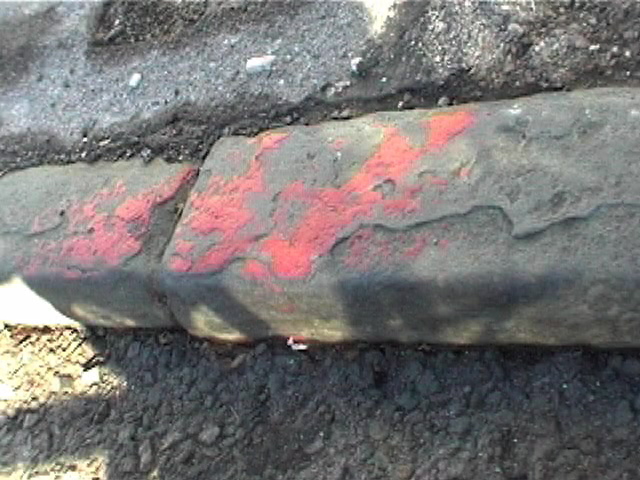
By Angela Piccini
Angela Piccini
Research Councils UK Fellow
Department of Drama: Theatre, Film, Television
University of Bristol
Cantocks Close
Bristol BS8 1UP
UK
Institution of Civil Engineers: Paving Aesthetics
Respect the kerb line — the kerb can be the key to making a street look like a street. It acts like the pediment to a Greek column, it provides continuity between adjoining buildings. Builidngs have a typical life of 100-200 years; the alignment of a road can have an indefinite lifetime. Changing the kerb line, or removing the kerb altogether can have a detrimental effect on the appearance of a street.

© Angela Piccini
58”–1’13
A long, rusty nail
Silver birch leaves
Chewed gum from countless mouths
Worked and painted kerb stone, the presence of nineteenth-century stone cutters and contemporary cable, water, sewer, telephone, road workers.
A drain
Tarmac and sandstone rub up against each other and hoard the grimy castings of the passersby. Plastic, soot, particulates, the remains of fossil fules from across the centuries, produced and consumed on a global level. It’s what connects my house to yours, my mouth to yours.
This is not a film. I wanted to explore how to do archaeology through a video practice but I am not a video practitioner. I work in a university drama department but they think I’m just an archaeologist. I work in a university archaeology department but they think I’m just a drama type. What I do once a week is research and teach archaeology for screen media, thinking beyond the standard broadcast expository documentary. I don’t know about available light and white balance, but I am there in the shadows, on tthose screens, here now. This doesn’t work as I skip ahead and slip behind time. But then that’s the point, too.
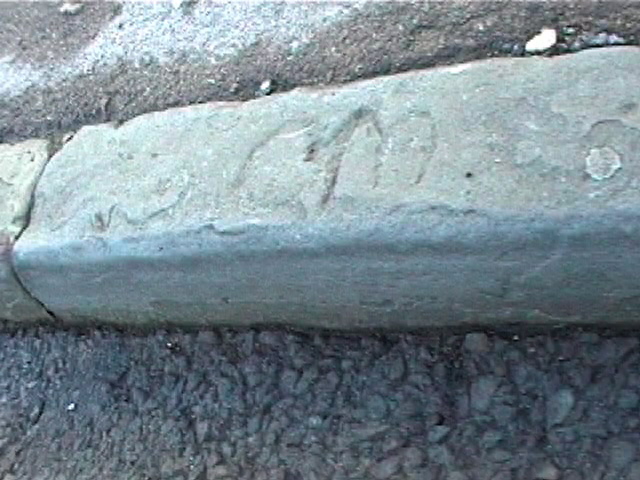
© Angela Piccini
2’05”
A ring and an M connecting kerbstones, Neolithic and now. Bob Jones, city council archaeologist tells me that no one’s paid much attention to the kerbs. These masons’ marks might be saying something about where the stone was quarried or where it was worked or it might indicate a production batch or be a location key. My interest sparks Bob’s and he tells me that this is a good field for documentary research.
2’21”
Sweet wrappers. A Bounty bar. Just bought from the Newsagents at the bottom of the road, or maybe leftovers from last night’s Halloween treats. The coconut, sugar and chocolate a perfect Bristol snack. The story of slavery and Bristol’s wealth all in one convenient bar. But I don’t suppose anyone else was seeing it that way that day. It’s always the archaeologist who brings that kind of thing up.
Institution of Civil Engineers: Paving Aesthetics
Design from the pedestrian’s perspective — pedestrians view paving from a height of 2 metres. A drawing board howver provides an aerial view equivalent to about 25 metres when the designer is working to a scale of 1 in 50. Some paving schemes include patterns that can only be appreciated from nearby office blocks, or passing aircraft. The design of many buildings falls into the same trap.
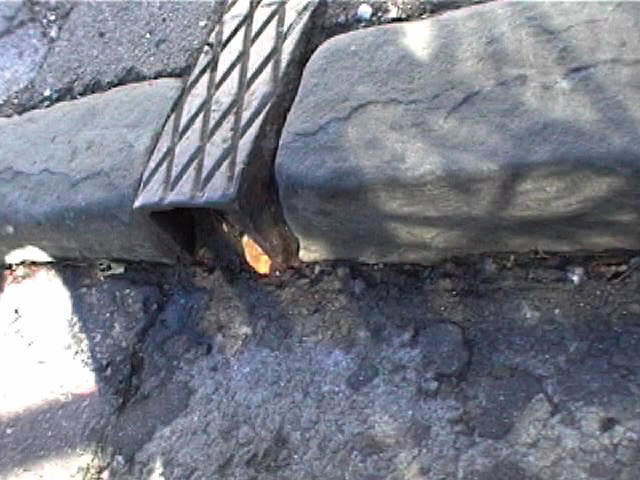
© Angela Piccini
A runoff drain cuts through one of the kerbs.
And in a minute there’s a gap in the kerb coming up, mirroring the change from tarmac pavement to brick paving.
13,598 cm, 168 kerbstones
This is the north side of Sandy Park Road, Brislington. A short stretch of high street in a once vibrant village, now a rundown neighbourhood on the up again due to the housing boom that confines me forever to tenancy. Further down the road, out of shot, was the Brislington Picture Palace, 1913-1955. There is a late 3rd, early 4th century Roman villa up at Winchester road. During excavations mosaics, a coin and the remains of 12 cattle and 4 humans were found. And there’s the incongruous WW2 pillbox tuck away below street level in the Sandy Park Road car park. Writer and asbestos campaigner Julie Burchill walked down this street when she lived here. And the 60 men and 89 boys from the so-called honeytrap at 49 Churchill Road, just around the corner, walked this street, their secrets safe, for over 20 years. No one had any idea. And perhaps some of those on their way to the Chapel of St Anne in the Woods, the third most important place of medieval pilgrimage, travelled this route. Henry VII visited twice - in 1486 and 1502. The Quakers were here in the 17th century. At St Anne’s Woods the State used dogs, whips and guns against the large dissident congretations. It’s a multivalent byway, the world in a gutter. The absent have all been down this way.
And I am walking this stretch of my meighbourhood on All Saints Day, 2003.
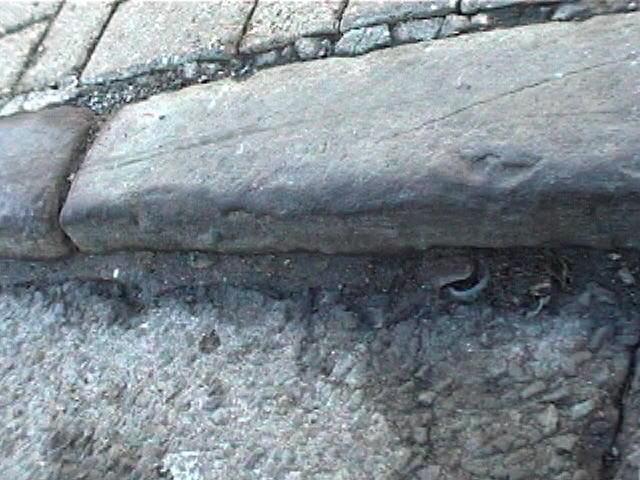
© Angela Piccini
5’34”
There’s a small castor encrusted with road grime. The sad social life of a thing. How did someone lose that? I know that out of shot is the end of the terrace, where the houses change to shops. One sold a few months back. Looks like whoever lived there now has a lopsided Ikea coffee table somewhere. No one thought to look in the gutter.
And then there was the cirucmflex and A carved into one kerb, or was it a theta? There is no patter to the distribution of these marks, no sense I can make that they were intended for one stretch and not the other. Did the parish council buy up a job lot of different batches in order to complete modernization? An archaeologist told me that once the kerbs wore down, they were turned over. The mason’s marks werent’ meant to be seen. But I’ve looked all round the city and haven’t found anything to compare. Are Brislingtonians particularly hard on their kerbs or is something else sltogether going on?
A lot of the Pennant sandstone in Bristol kerbs came from Snuff Mills, Stapleton, quarried by Maberly Parker after he bought the place in 1879. Thomas Henry Kichin ran the mill on Parker’s behalf. Is that why in land-locked Brislington it’s either Sandy Park, Sandown, Sandholme, Sandwich, Sandhurst? Even the 90-year old keeper of the church crypt key, who’s lived here since she was a baby doesn’t know why and tells me that her family spent a lot of time once doing some unfruitful research.
The daily shopping at green grocer and butcher, the school trips, visits to the post office, friends, the local funeral director - our retracing the steps of this 19th-century avenue of industrial expansion, itself overlaying those earlier pathways, makes this gutterscape.
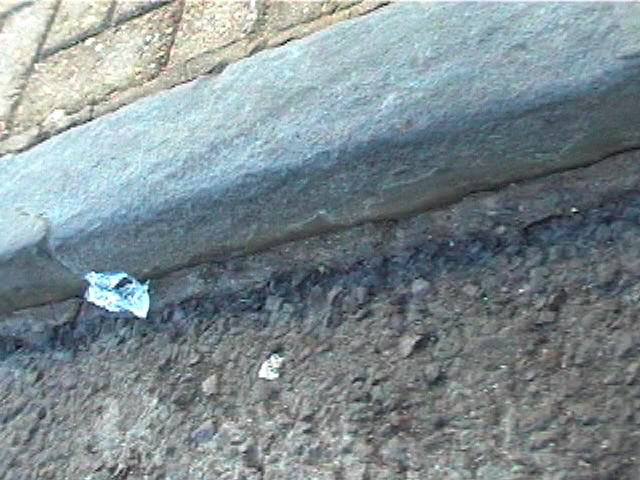
© Angela Piccini
Watch for the boiled sweet wrapper. There’s something quite beautiful about the way it blows along the gutter. The plastic is the only stuff that moves here. While kids stick with cola bottles, flumps and the gelatine menagerie these occasional sweet wrappers seem to point to elserly women out for their morning walks, just popping in a humbug to soothe a cough. My gran was one of those and my mum’s becoming one. But then again, it was Halloween last night. Maybe the kids get rid of these sweets first so they can get to the chocolate.
8’02”
Out of the corner of your eye is a passing child on a bike.
Excuse me love, what are you doing walking in the middle of the road? I’m not using the pushchair or the streetscene in the proper way. Who ever heard of putting a pillow in a pushchair and tying a camcorder on to it with pipecleaners? I don’t think I’ve left anything behind, but my wheels grind through the grit, making it hard to keep a steady pace. So I leave subtle tracks in this gutter and embedded in my wheels are the remains of the other people who’ve gone this way, their traces worked into the fibres of my own front hall carpet.
8’21”
I have to walk around a jeep about now. The jeep and the well meaning woman from Sandy’s diner, the place you can’t see with the sausage eating pigs on the plate glass, forces me to acknowledge that I have disturbed the natural order of things with this timecoded walk in the road. My street just another mediatized place. The jeep is the proper American kind. It’s parked on the double yellows so it shouldn’t be there but it got there via the docks at Avonmouth, row after row of cars fresh off the boat, economic migrants — just like me.
The creep of the tarmac up the sides of the kerbs makes me want to peel it back, like a scab.
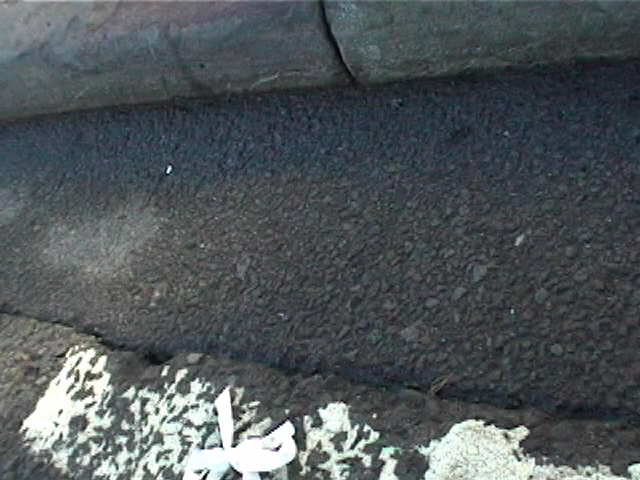
© Angela Piccini
13’01”
A beautifully tied ribbon: surprisingly clean and fresh like it’s just slipped out of a little girl’s hair or off a Saturday birthday present.
And have you noticed all the tire marks on the curb? But like I said, it’s double yellows all the way so there’s some serious contravention of the highway code going on here. The plastic, the soot, the tire marks — it’s all about the petro-chemicals in this place. This is the quotidian, the everyday of global capital exchange. The kerb and the gutter are where Brislington meets the rest of the world.
A firework casing points to ritualized Halloween behavious and makes me notice the spectral white face painted on the tarmac.
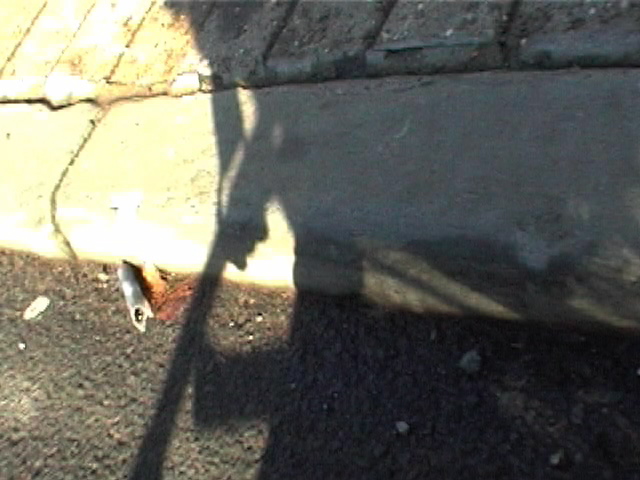
© Angela Piccini
The 168 kerbstones average 81cm. But the shortest is just 33cm while the longest is 153cm. The ebb and flow of individual measurement reads like poetry: 78, 145, 125, 87, 92, 81, 54 or 59, 46, 92, 91, 91, 91, 91, 92, 45. Those mass-produced 91s tell of the construction of the zebra crossing with its intrusion of concrete kerbs.
Our neighbours, Heather and Les, have lived here for 40 years. She volunteers at the St Peters Hospice shop on Sandy Park, which connects her to my mother in a different way. Heather and Les remember this as a nice area where all the housewives would scrub the front step every day. They don’t like multiculturalism around here, but I’m ok because I’m Canadian. There’s also Mary, whose Polish-born husband died a while back after a short struggle with cancer. She and my mother talked together for a while but my mum drew the line - grief support is fine but she didn’t want friendship. These street relationships are all about drawing and redrawing sacred boundaries, social ley lines.
Just around the corner is the European capital of one of the more millennial sects of the Brethren, which believes Brislington will be the epicentre of the apocalypse. Most people I talk to think they’re the Plymouth brethren, but in 1738 the Moravian church of the Unity of the Brethren was carried to Great Britain chiefly through the mission work of Peter Boehler, who was also instrumental in John Wesley’s spiritual pilgrimage. The congregation was settled in Bristol on January 26 1755.
13’55”
Another storm drain and more fag ends. No evidence of rollies. We’re a proud community here and Brislington is also one of the worst or best areas in Bristol for heart disease.
The amount of material accumulating in the gutter is increasing now. Is this due to the fact that I’m nearing the bottom of the fill and the wind howels down this road? But I’m also just outside the newsagents and nearing the Sandringham pub. My mother and son refuse to walk outside the Sandringham - they call it the dirty side of the street in a strangely anthopological mapping. I could have shot the whole of this outside the pub but figured vomit, dog mess and sputum might offend morre polite audiences. My mother refers to it as that dreadful place.
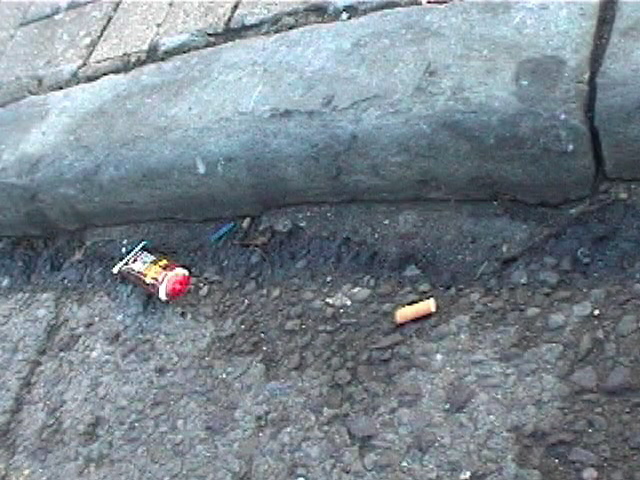
© Angela Piccini
As I reach the end of this I find the best stuff Two empty bottles of fake blood, different brands. I imagine someone applying this viscera in the dark, on the pavement. What other ways could these squeezed-dry bottles have reached this spot? Perhaps people leaving the Sandringham on their way to a Halloween party, a little worse for wear.
So here is a locale, 13,598 cm. But of course these words and the 14 minutes of video and sound are just material traces of the space that I paced and together they tell just one story of that morning, and even that is different each time I tell it.
Institution of Civil Engineers: Paving Aesthetics
Paving matters. About one third of a typical streetscene is occupied by road, kerb and fottways and these surfaces greatly affect the appearance of a street. As a rule paving should be of secondary importance to buildings. Items which influence the streetscene include:
Builidngs
Verges, trees and landscaping
Street furniture and signs
Street lighting
Road and foolway surfacing materials
yellow and centre lines
any curve to the road surface or super elevation
kerb
Biography
Angela Piccini's background is in transdisciplinary research and public-sector heritage work, with a particular focus on the performativity of 'pastness'. Following a BA in English / Art History from University of British Columbia and an MA and PhD in Archaeology (1999 Celtic Constructs: Heritage Media, Archaeological Knowledge and the Politics of Consumption in 1990s Britain) from University of Sheffield Piccini worked on geographies of heritage and then as as Publications Officer for Cadw: Welsh Historic Monuments before taking up research in performance and screen media.
Piccini focuses on archaeology as a contemporary attitude towards understanding place, material and performativity. Her research explores the intersections among archaeology, performance, screen practice and mixed-mode research in the contemporary built environment. She currently holds a Research Councils UK Fellowship in Performativity, Place, Space, and is researching the use of Semantic Web in a locative media context.